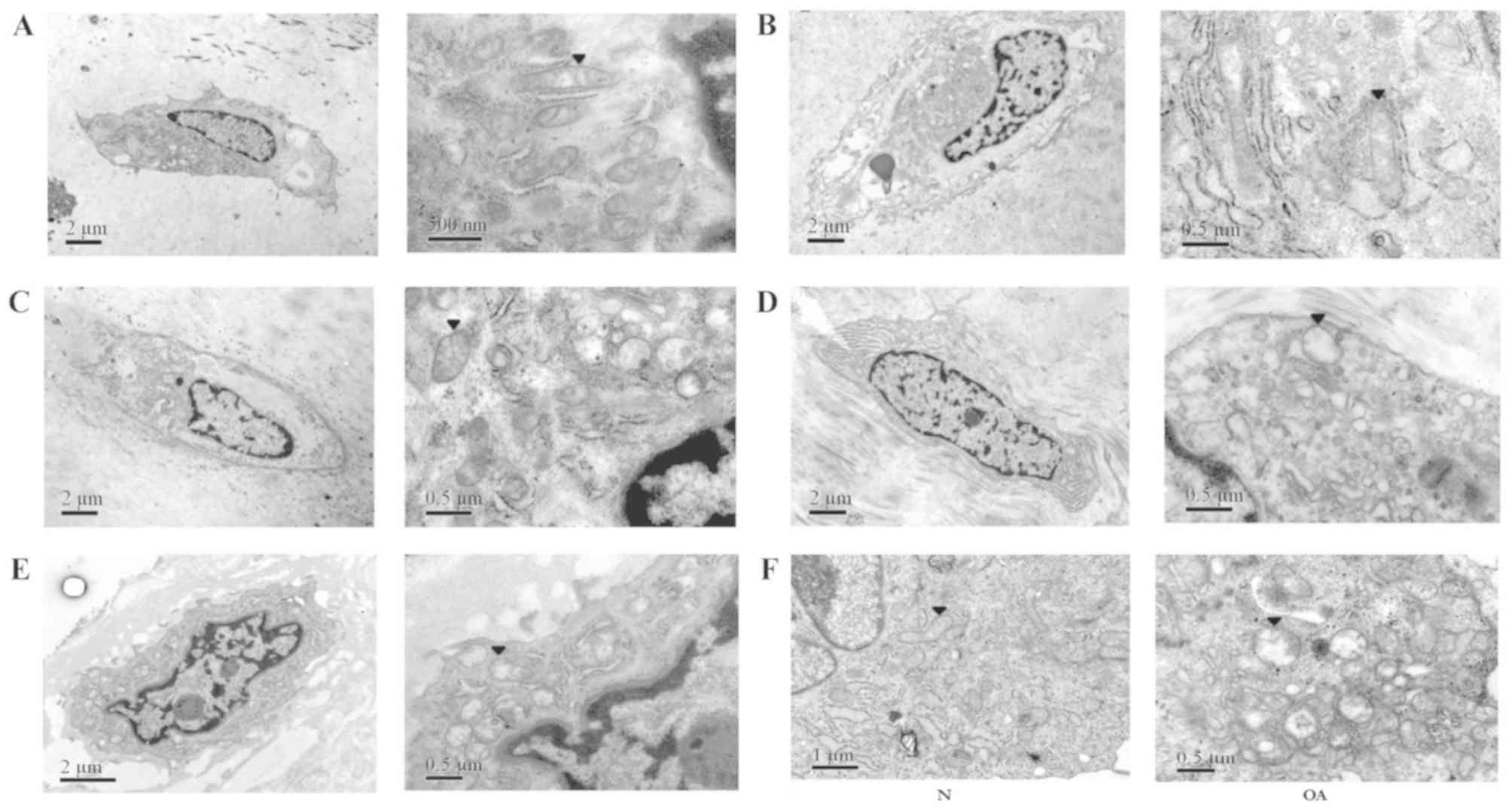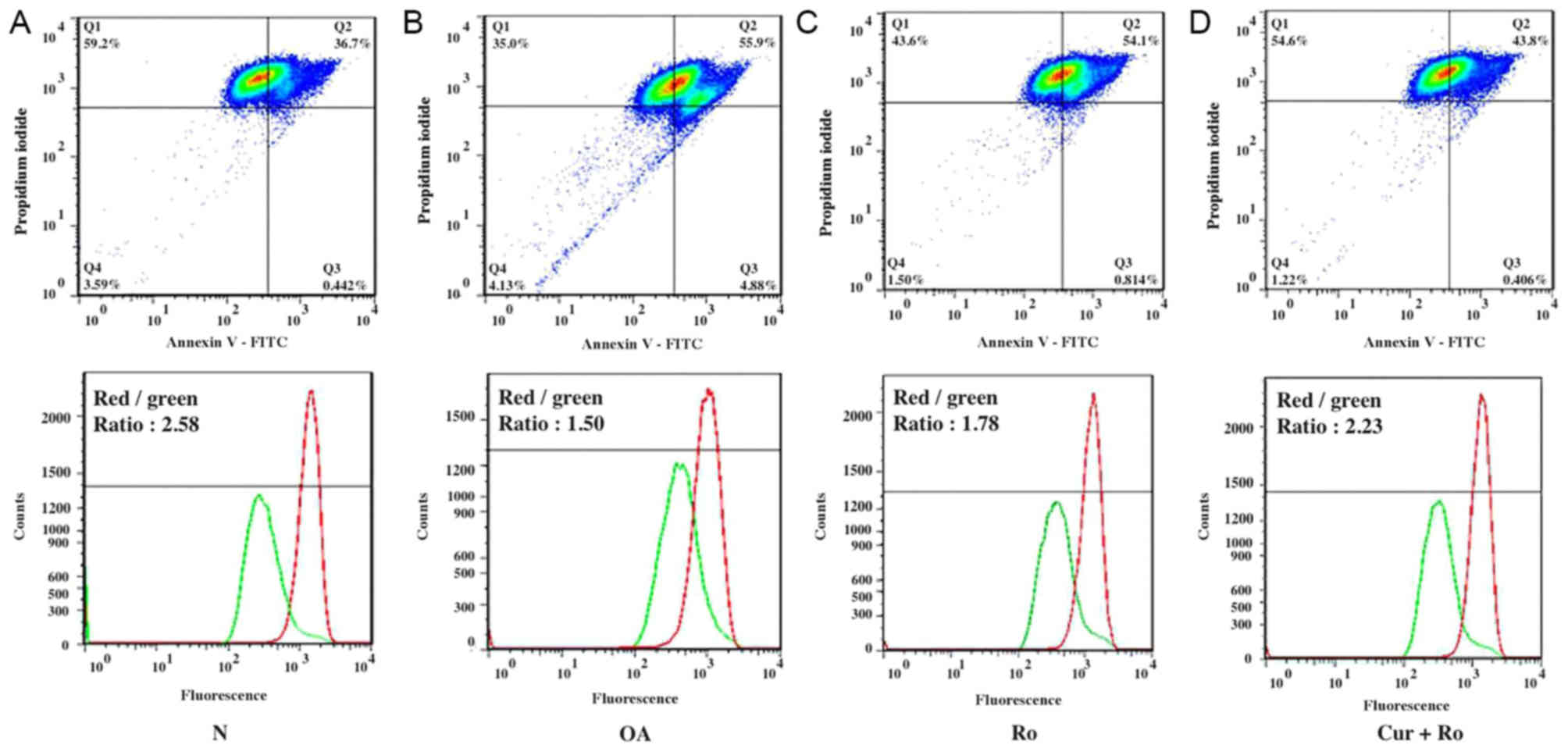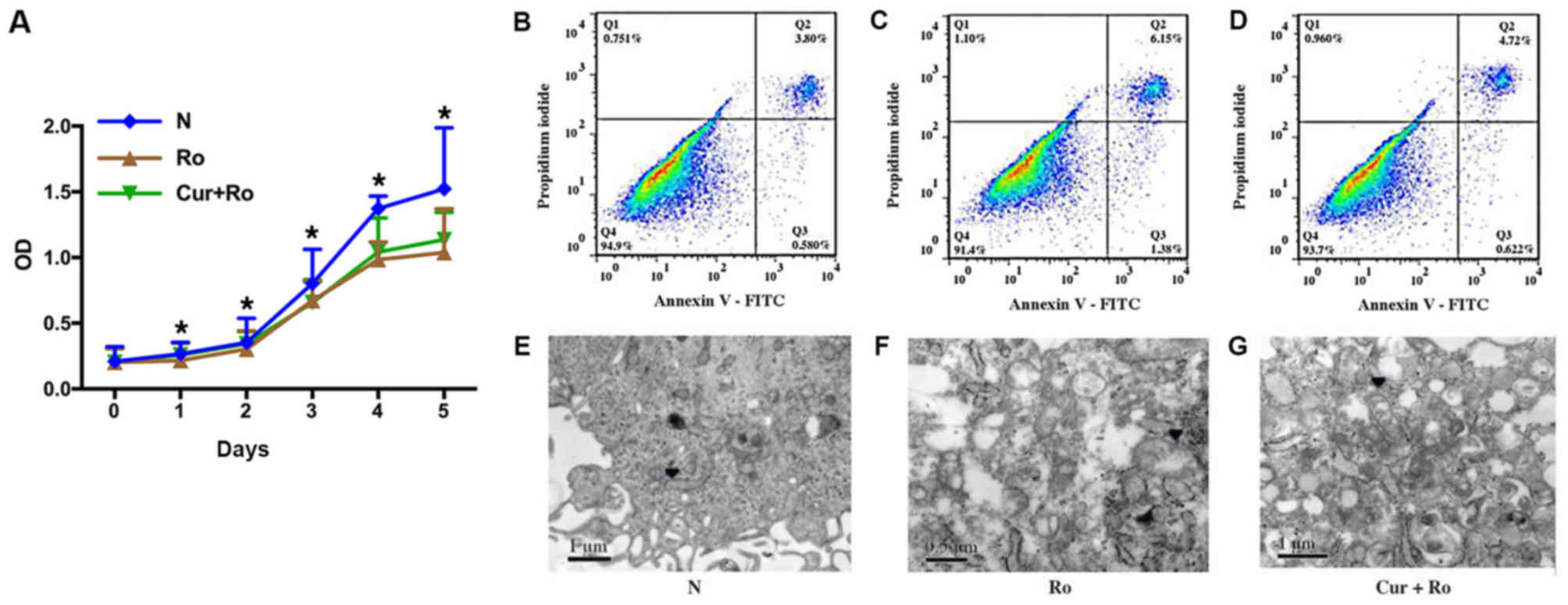|
1
|
Blanco FJ, Guitian R, Vázquez-Martul E, de
Toro FJ and Galdo F: Osteoarthritis chondrocytes die by apoptosis:
A possible pathway for osteoarthritis pathology. Arthritis Rheum.
41:2841998. View Article : Google Scholar : PubMed/NCBI
|
|
2
|
Buckwalter JA and Mankin HJ: Articular
cartilage: Degeneration and osteoarthritis, repair, regeneration,
and transplantation. Instr Course Lect. 47:487–504. 1998.PubMed/NCBI
|
|
3
|
Otte P: Basic cell metabolism of articular
cartilage. Manometric studies. Z Rheumatol. 50:304–312.
1991.PubMed/NCBI
|
|
4
|
Falchuk KH, Goetzl EJ and Kulka JP:
Respiratory gases of synovial fluids. An approach to synovial
tissue circulatory-metabolic imbalance in rheumatoid arthritis. Am
J Med. 49:223–231. 1970. View Article : Google Scholar : PubMed/NCBI
|
|
5
|
Morgan-Hughes JA, Darveniza P, Kahn SN,
Landon DN, Sherratt RM, Land JM and Clark JB: A mitochondrial
myopathy characterized by a deficiency in reducible cytochrome b.
Brain. 100:617–640. 1977. View Article : Google Scholar : PubMed/NCBI
|
|
6
|
Beregi E and Regius O: Comparative
morphological study of age related mitochondrial changes of the
lymphocytes and skeletal muscle cells. Acta Morphol Hung.
35:219–224. 1987.PubMed/NCBI
|
|
7
|
Takamiya S, Yanamura W, Capaldi RA,
Kennaway NG, Bart R, Sengers RC, Trijbels JM and Ruitenbeek W:
Mitochondrial myopathies involving the respiratory chain: A
biochemical analysis. Ann N Y Acad Sci. 488:33–43. 1986. View Article : Google Scholar : PubMed/NCBI
|
|
8
|
Ishikawa Y, Chin JE, Hubbard HL and
Wuthier RE: Utilization and formation of amino acids by chicken
epiphyseal chondrocytes: Comparative studies with cultured cells
and native cartilage tissue. J Cell Physiol. 123:79–88. 1985.
View Article : Google Scholar : PubMed/NCBI
|
|
9
|
Kühn K, D'Lima DD, Hashimoto S and Lotz M:
Cell death in cartilage. Osteoarthritis Cartilage. 12:1–16. 2004.
View Article : Google Scholar : PubMed/NCBI
|
|
10
|
Perkins G, Renken C, Martone ME, Young SJ,
Ellisman M and Frey T: Electron tomography of neuronal
mitochondria: Three-dimensional structure and organization of
cristae and membrane contacts. J Struct Biol. 119:260–272. 1997.
View Article : Google Scholar : PubMed/NCBI
|
|
11
|
Maneiro E, Martín MA, de Andres MC,
López-Armada MJ, Fernández-Sueiro JL, del Hoyo P, Galdo F, Arenas J
and Blanco FJ: Mitochondrial respiratory activity is altered in
osteoarthritic human articular chondrocytes. Arthritis Rheum.
48:700–708. 2003. View Article : Google Scholar : PubMed/NCBI
|
|
12
|
Ernster L and Schatz G: Mitochondria: A
historical review. J Cell Biol. 91:227s–255s. 1981. View Article : Google Scholar : PubMed/NCBI
|
|
13
|
Chauvin C, De Oliveira F, Ronot X,
Mousseau M, Leverve X and Fontaine E: Rotenone inhibits the
mitochondrial permeability transition-induced cell death in U937
and KB cells. J Biol Chem. 276:41394–41398. 2001. View Article : Google Scholar : PubMed/NCBI
|
|
14
|
Navarro A, Bández MJ, Gómez C, Repetto MG
and Boveris A: Effects of rotenone and pyridaben on complex I
electron transfer and on mitochondrial nitric oxide synthase
functional activity. J Bioenerg Biomembr. 42:405–412. 2010.
View Article : Google Scholar : PubMed/NCBI
|
|
15
|
DiDonato S, Zeviani M, Giovannini P,
Savarese N, Rimoldi M, Mariotti C, Girotti F and Caraceni T:
Respiratory chain and mitochondrial DNA in muscle and brain in
Parkinson's disease patients. Neurology. 43:2262–2268. 1993.
View Article : Google Scholar : PubMed/NCBI
|
|
16
|
Li N, Ragheb K, Lawler G, Sturgis J, Rajwa
B, Melendez JA and Robinson JP: Mitochondrial complex I inhibitor
rotenone induces apoptosis through enhancing mitochondrial reactive
oxygen species production. J Biol Chem. 278:8516–8525. 2003.
View Article : Google Scholar : PubMed/NCBI
|
|
17
|
Jackson JK, Higo T, Hunter WL and Burt HM:
The antioxidants curcumin and quercetin inhibit inflammatory
processes associated with arthritis. Inflamm Res. 55:168–175. 2006.
View Article : Google Scholar : PubMed/NCBI
|
|
18
|
Cole GM, Teter B and Frautschy SA:
Neuroprotective effects of curcumin. Adv Exp Med Biol. 595:197–212.
2007. View Article : Google Scholar : PubMed/NCBI
|
|
19
|
Asai A and Miyazawa T: Dietary
curcuminoids prevent high-fat diet-induced lipid accumulation in
rat liver and epididymal adipose tissue. J Nutr. 131:2932–2935.
2001. View Article : Google Scholar : PubMed/NCBI
|
|
20
|
Outerbridge RE: The etiology of
chondromalacia patellae. J Bone Joint Surg Br. 43:752–757. 1961.
View Article : Google Scholar : PubMed/NCBI
|
|
21
|
Klagsbrun M: Large-scale preparation of
chondrocytes. Methods Enzymol. 58:560–564. 1979. View Article : Google Scholar : PubMed/NCBI
|
|
22
|
Morgan-Hughes JA, Hayes DJ, Clark JB,
Landon DN, Swash M, Stark RJ and Rudge P: Mitochondrial
encephalomyopathies: Biochemical studies in two cases revealing
defects in the respiratory chain. Brain. 105:553–582. 1982.
View Article : Google Scholar : PubMed/NCBI
|
|
23
|
Shapiro HM: Membrane potential estimation
by flow cytometry. Methods. 21:271–279. 2000. View Article : Google Scholar : PubMed/NCBI
|
|
24
|
Kongtawelert P and Ghosh P: A new
sandwich-ELISA method for the determination of keratan sulphate
peptides in biological fluids employing a monoclonal antibody and
labelled avidin biotin technique. Clin Chim Acta. 195:17–26. 1990.
View Article : Google Scholar : PubMed/NCBI
|
|
25
|
Aigner T, Kurz B, Fukui N and Sandell L:
Roles of chondrocytes in the pathogenesis of osteoarthritis. Curr
Opin Rheumatol. 14:578–584. 2002. View Article : Google Scholar : PubMed/NCBI
|
|
26
|
Ma Q, Fang H, Shang W, Liu L, Xu Z, Ye T,
Wang X, Zheng M, Chen Q and Cheng H: Superoxide flashes: Early
mitochondrial signals for oxidative stress-induced apoptosis. J
Biol Chem. 286:27573–27581. 2011. View Article : Google Scholar : PubMed/NCBI
|
|
27
|
Higuchi M, Proske RJ and Yeh ET:
Inhibition of mitochondrial respiratory chain complex I by TNF
results in cytochrome c release, membrane permeability transition,
and apoptosis. Oncogene. 17:2515–2524. 1998. View Article : Google Scholar : PubMed/NCBI
|
|
28
|
Lee HC, Yin PH, Lu CY, Chi CW and Wei YH:
Increase of mitochondria and mitochondrial DNA in response to
oxidative stress in human cells. Biochem J. 348:425–432. 2000.
View Article : Google Scholar : PubMed/NCBI
|
|
29
|
Almeida A, Almeida J, Bolaños JP and
Moncada S: Different responses of astrocytes and neurons to nitric
oxide: The role of glycolytically generated ATP in astrocyte
protection. Proc Natl Acad Sci USA. 98:15294–15299. 2001.
View Article : Google Scholar : PubMed/NCBI
|
|
30
|
Goossens V, Stangé G, Moens K, Pipeleers D
and Grooten J: Regulation of tumor necrosis factor-induced,
mitochondria- and reactive oxygen species-dependent cell death by
the electron flux through the electron transport chain complex I.
Antioxid Redox Signal. 1:285–295. 1999. View Article : Google Scholar : PubMed/NCBI
|
|
31
|
Yook YH, Kang KH, Maeng O, Kim TR, Lee JO,
Kang KI, Kim YS, Paik SG and Lee H: Nitric oxide induces BNIP3
expression that causes cell death in macrophages. Biochem Biophys
Res Commun. 321:298–305. 2004. View Article : Google Scholar : PubMed/NCBI
|
|
32
|
Distelmaier F, Koopman WJ, van den Heuvel
LP, Rodenburg RJ, Mayatepek E, Willems PH and Smeitink JA:
Mitochondrial complex I deficiency: From organelle dysfunction to
clinical disease. Brain. 132:833–842. 2009. View Article : Google Scholar : PubMed/NCBI
|
|
33
|
Reddy AC and Lokesh BR: Studies on spice
principles as antioxidants in the inhibition of lipid peroxidation
of rat liver microsomes. Mol Cell Biochem. 111:117–124.
1992.PubMed/NCBI
|
|
34
|
Koiram PR, Veerapur VP, Kunwar A, Mishra
B, Barik A, Priyadarsini IK and Mazhuvancherry UK: Effect of
curcumin and curcumin copper complex (1:1) on radiation-induced
changes of anti-oxidant enzymes levels in the livers of Swiss
albino mice. J Radiat Res (Tokyo). 48:241–245. 2007. View Article : Google Scholar
|
|
35
|
Le Goffe C, Vallette G, Jarry A, Bou-Hanna
C and Laboisse CL: The in vitro manipulation of carbohydrate
metabolism: A new strategy for deciphering the cellular defence
mechanisms against nitric oxide attack. Biochem J. 3:643–648. 1999.
View Article : Google Scholar
|
|
36
|
Aulwurm UR and Brand KA: Increased
formation of reactive oxygen species due to glucose depletion in
primary cultures of rat thymocytes inhibits proliferation. Eur J
Biochem. 267:5693–5698. 2000. View Article : Google Scholar : PubMed/NCBI
|



















